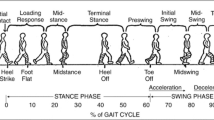Abstract
Backpacks are our commonly used tools to transport materials. However, when people are walking, the center of gravity of the human body will vibrate up and down with a certain amplitude and frequency. The traditional backpack vibrates vertically at the same amplitude and frequency as the human’s COM movement, which will have a huge impact on the human body and increase energy consumption. In this paper, the model of human-backpack is analyzed and an active and passive mixing suspended backpack is designed, which had the ideal effect of reducing acceleration force, amplitude and improving energy efficiency. Through the prototype experiment and the walking test, it is verified that low damping and low stiffness can improve the damping performance of the backpack, and the effect of decreasing amplitude and acceleration force reduction of the backpack under the optimal parameters are obtained.
Access this chapter
Tax calculation will be finalised at checkout
Purchases are for personal use only
Similar content being viewed by others
References
Gonzalez, D.J., Asada, H.H.: Design of extra robotic legs for augmenting human payload capabilities by exploiting singularity and torque redistribution. In: Maciejewski, A. (ed.) 2018 IEEE/RSJ International Conference on Intelligent Robots and Systems (IROS), pp. 4348–4354. IEEE, Madrid (2018)
Park, J.-H., Stegall, P., Zhang, H., Agrawal, S.: Walking with a backpack using load distribution and dynamic load compensation reduces metabolic cost and adaptations to loads. IEEE Trans. Neural Syst. Rehabil. Eng. 25(9), 1419–1430 (2017)
Rome, L.C., Flynn, L., Yoo, T.D.: Biomechanics: rubber bands reduce the cost of carrying loads. Nature 444(7122), 1023–1024 (2006)
Foissac, M., Millet, G.Y., Geyssant, A., Freychat, P., Belli, A.: Characterization of the mechanical properties of backpacks and their influence on the energetics of walking. J. Biomech. 42(2), 125–130 (2009)
Ackerman, J., Seipel, J.: A model of human walking energetics with an elastically-suspended load. J. Biomech. 47(8), 1922–1927 (2014)
Hoover, J., Meguid, S.A.: Performance assessment of the suspended backpack. Int. J. Mech. Mater. Des. 7(2), 111–121 (2011)
Saunders, J.B., Inman, V.T., Eberhart, H.D.: The major determinants in normal and pathological gait. J. Bone Joint Surg. 35(3), 543–558 (1953)
Grieve, D.W., Gear, R.J.: The relationships between length of stride, step frequency, time of swing and speed of walking for children and adults. Ergonomics 9(5), 379–399 (1966)
Roebuck, J.A., Kroemer, K.H.E., Thomson, W.G.: Engineering Anthropometry Methods. Wiley-Interscience, New York (1975)
Xu, X.: An investigation on the interactivity between suspended backpack and human gait. Graduate dissertation, Faculty of North Carolina State University, Raleighc (2008)
Acknowledgement
This research was funded by the National Natural Science Foundation of China (61703124), and the Self-Planned Task (NO. SKLRS201714A) of State Key Laboratory of Robotics and System (HIT).
Author information
Authors and Affiliations
Corresponding author
Editor information
Editors and Affiliations
Rights and permissions
Copyright information
© 2021 Springer Nature Switzerland AG
About this paper
Cite this paper
Zhang, B., Zhang, S., Zeng, X., Fu, Y. (2021). Performance Analysis of a Suspended Backpack Minimizing the Vertical Acceleration for Human Load Carriage. In: Liu, XJ., Nie, Z., Yu, J., Xie, F., Song, R. (eds) Intelligent Robotics and Applications. ICIRA 2021. Lecture Notes in Computer Science(), vol 13013. Springer, Cham. https://doi.org/10.1007/978-3-030-89095-7_63
Download citation
DOI: https://doi.org/10.1007/978-3-030-89095-7_63
Published:
Publisher Name: Springer, Cham
Print ISBN: 978-3-030-89094-0
Online ISBN: 978-3-030-89095-7
eBook Packages: Computer ScienceComputer Science (R0)




